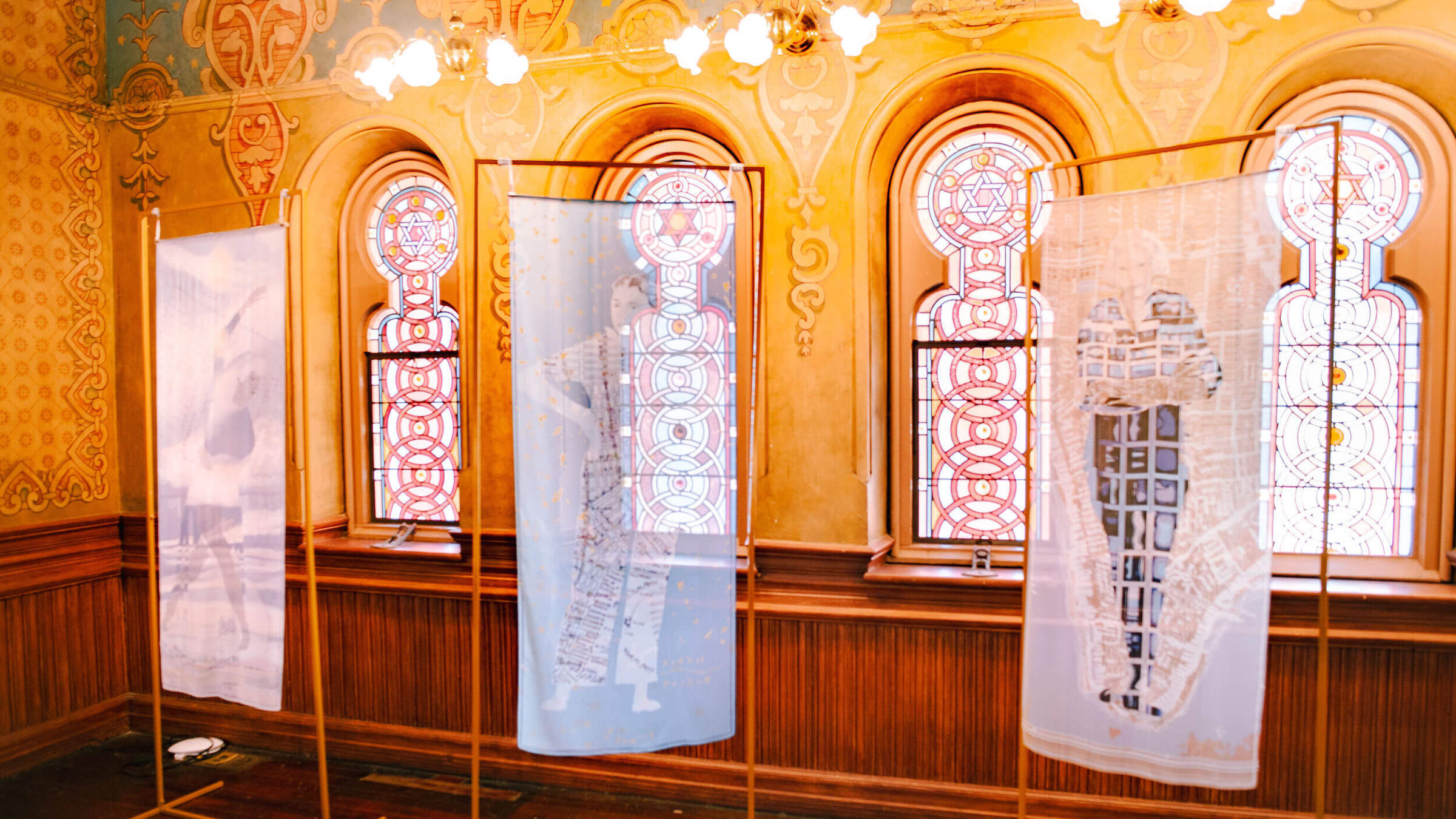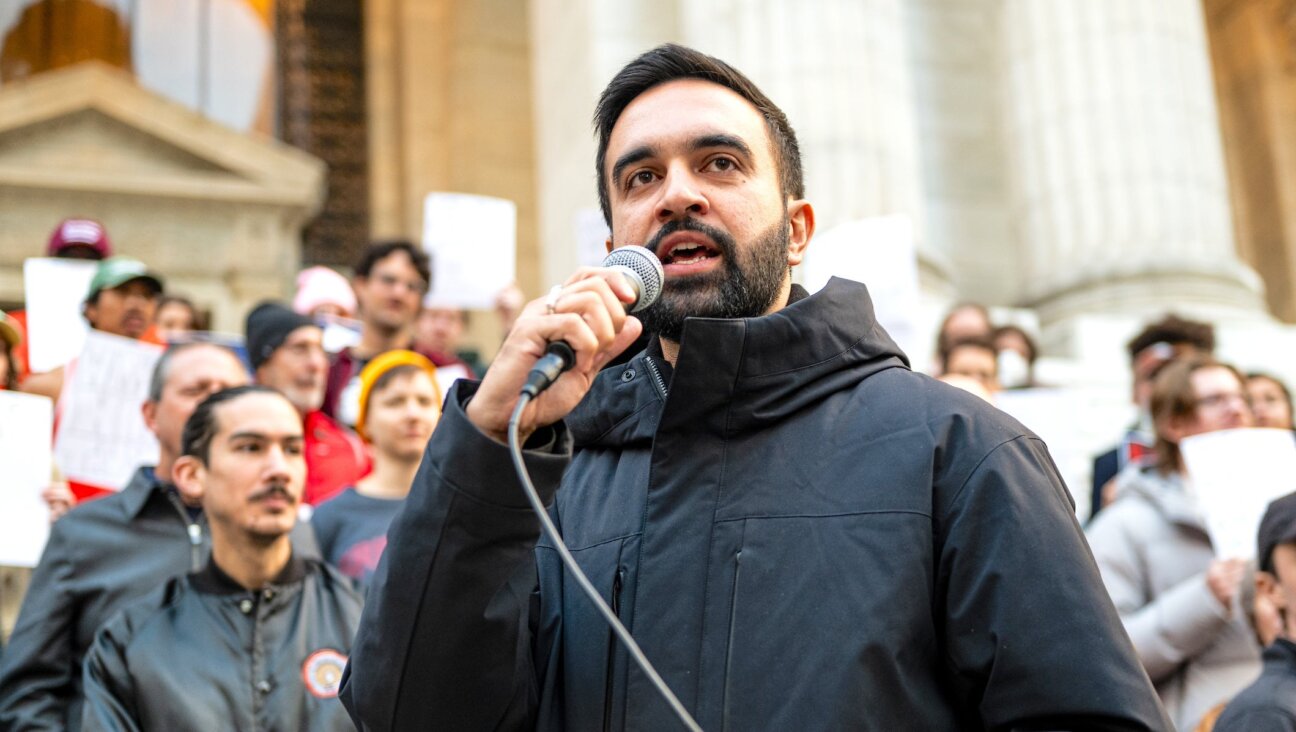‘An ethereal presence’: An artist gives the women of the old Lower East Side new life
At the Eldridge Street Synagogue, artist Adrienne Ottenberg pays homage to turn-of-the-century Jewish women

Painted banners included in Adrienne Ottenberg’s new solo show at the Museum at Eldridge Street. Courtesy of the Museum at Eldridge Street
On entering the Eldridge Street Synagogue, visitors are — at least for now — greeted by a large banner printed with a blue-and-white watercolor rendition of the synagogue’s Moorish facade.
Superimposed on the watercolor are bright yellow crinkles and stars reminiscent of a brilliant meteor shower. It’s easy to miss the diminutive figure sitting on the steps of the synagogue, painted in a ghostly gray. She is Gittel Natelson, an Eastern European Jew who immigrated to the U.S. in 1868 and operated the mikveh at the same synagogue her portrait now temporarily hangs in.
The banner is part of artist Adrienne Ottenberg’s new solo show, On the Lower East Side: Twenty-Eight Remarkably Women … and One Scoundrel. Ottenberg, an illustrator and cartographer, created multimedia portraits of 29 women who lived or worked in the crowded chaos of the Lower East Side at the turn of the 20th century. These portraits, printed on large vertical banners made of cotton and silk, now float in the synagogue’s sanctuary, stairwells, and balconies.
Ottenberg’s delicate watercolor style gives her portraits an otherworldly character, as does her choice to hang the banners on freestanding frames. “They’re designed so that as you walk past them, they move,” said Nancy Johnson, curator at the museum. “It creates kind of an ethereal presence … a little bit of interaction between the past and the present.”
The women are an eclectic bunch — poets, labor organizers, dancers — and the exhibit focuses on their contributions to culture and a variety of social justice movements, from women’s suffrage to worker’s rights. “My choice of the women was pretty idiosyncratic,” Ottenberg said during the exhibition’s opening. “Some of them are famous, and some are not. Some of them should be famous.”
Those featured include Emma Goldman, anarchist revolutionary and women’s rights activist; Elizabeth Tyler, the first Black nurse hired at the Henry Street Settlement, who worked to provide healthcare to the underserved Black populace; and Cora La Redd, a well-known singer and tap dancer born on Broome Street.
On the front gallery wall, a transparent gray silhouette of Frances Perkins is overlaid on an electoral map of lower Manhattan. Perkins was a social worker and consumer advocate; after witnessing the Triangle Shirtwaist factory fire, she spearheaded the investigation of the fire and advocated for labor reform laws, eventually becoming the first woman to serve in a presidential Cabinet when Franklin Delano Roosevelt appointed her Secretary of Labor.
A few yards to the right of Perkins hangs a portrait of Dora Welfowitz, a Russian Jewish immigrant who lived in the U.S. for only a year before perishing at age 20 in that same fire. Here, she is on equal footing with celebrated historical figures like Perkins, a reminder to viewers that social change is not just the product of a few brilliant iconoclasts.
Welfowitz stands amid clouds with her hands clasped together, her hair a mass of tangled blue flames. Her singed gown is made of a 19th-century “Firemen’s guide” map of lower Manhattan that displays the city’s fire districts. The location of the factory, positioned over her heart, is obscured by a cigarette burn.
Ottenberg has a special talent for bringing out the geometric beauty of maps. In these banners, the jumbled streets of lower Manhattan are transformed into the creases of a skirt; quotes and descriptions of the women are inserted in curving text that mirrors the contours of the land.
After working for many years as an illustrator, Ottenberg started creating her own maps, eventually earning a master’s degree in geography at the City University of New York to learn computer mapping. In addition to the maps featured in each portrait, Ottenberg created a large map of the Lower East Side to show which areas each woman was connected to and guide viewers through the exhibit.
One of Ottenberg’s goals was to create a “sense of place” — to give visitors a taste of the vibrancy and chaos of the Lower East Side over a century ago. To that end, she did not shy away from the neighborhood’s less-than-model citizens.
The exhibit’s eponymous scoundrel is tucked away in the women’s balcony, perhaps searching for her next target. She is Stiff Rivka, a pickpocket who was especially adept at stealing from congregants during shul. The sole record of her existence is a short entry in the Police Gazette warning of her misdeeds. Ottenberg’s portrait depicts her in a playful stance beneath the gazette’s masthead, wearing dark glasses and proudly displaying a coin.
“I could not resist Stiff Rivka,” Ottenberg said. “It wasn’t just all these amazing women, doing these incredible things — there were people doing really questionable stuff.”
One of the most pleasing aspects of the exhibition is how well-suited it is to the space. The synagogue is lined with gorgeous stained glass depicting Stars of David and geometric patterns, filling the sanctuary with colorful light that gives the banners a shimmering, bejeweled effect.
The night sky backgrounds and bright stars included in many of the banners echo the five-point stars that dot the synagogue’s walls and ceiling, and which feature prominently in the stunning rose window created by Kiki Smith in 2010.
This symbiosis is no coincidence; Ottenberg cites a visit to the synagogue in the 1990s as planting the seeds of her idea for the exhibit. At that point, the main sanctuary was still cordoned off to congregants — as it had been since 1955 due to the cost of maintenance — and Ottenberg’s visit occurred at the beginning of extensive 20-year renovations.
“It was glorious, even with the ceiling falling in, the dirt and broken windows,” she writes. “It was haunted, I was sure.”






















